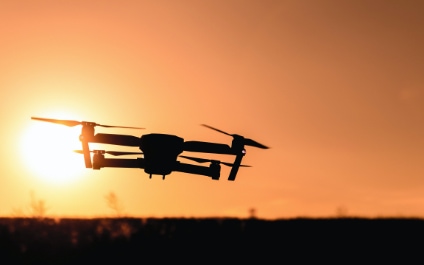
When a person hears the word “drone” a myriad of thoughts may come to mind. Some may think of the nefarious ways they are used. Some may imagine a photographer doing a fly-over at a wedding, while others may consider them an invasion of personal space or privacy. Clearly, there are many applications for drones with both positive and negative connotations. This blog illustrates some of the negative utilizations of drones while encouraging the reader to be open-minded for the positive applications and future possibilities for this inventive technology.
The Case Against Drones
Unfortunately, drones have been used to cause mass destruction and threaten the safety of innocent people. For example, just over a year ago, drones were used to attack two key Saudi Aramco oil production plants in Saudi Arabia. This large and sophisticated attack occurred at Abqaiq, Aramco’s largest oil plant, and Khurais, causing oil production to fall by half in the weeks following the damage. The culpability for the drone attack was quickly placed on the Houthi rebel group in Yemen. However, it is hard to be sure who is responsible for the attack, given the number of drones deployed and the complexity of the attack. Some believe Iran is the true culprit, as relations between Saudi Arabia and Iran remain volatile.
In light of this, it is evident that drones present the very real opportunity for targeted, large-scale attacks. Drone attacks make it incredibly difficult to know where the attack came from, as evidenced in the case of the Aramco oil plants. Drones are also a relatively cheap technology to deploy, making the cost to defend against drone attacks often exponentially more expensive than the cost to utilize them in targeted attacks. Finally, because of the remote operation of drones, the violence in drone attacks is depersonalized from the operator. All of these factors combine to make it easy to use drones to carry out horrific acts, causing many to shy away from supporting the development of drone technology.
The Case For Drones
Despite the many war atrocities and terrorist attacks, there truly are many benefits of drones when not used for violence. One of the best uses for drones is in emergency and disaster response. For example, in 2011, when a tsunami in Japan damaged the Fukushima Daiichi nuclear power plant, ground drones were used to assess damage and detect radiation levels so that human responders would not have to put themselves at risk.
More recently, responders have begun using unmanned aerial vehicles (UAVs) to provide an even greater scope of data during incidents such as wildfires and volcanic eruptions. In 2018, when wildfires raged wildly in California, UAVs were used to determine the direction of the fires and identify hot spots for firefighters to focus on. That same year, UAVs were deployed in Hawaii to monitor volcanic eruptions. These drones charted lava flows moving towards homes or communities and detected levels of toxic gases being released into the air. In each of these cases, drones provided real-time data that allowed incident commanders to make timely decisions, first responders to respond more swiftly, and authorities to alert and evacuate endangered communities more efficiently.
Why were these drones crucially important to first responders? CEO of Project Owl, Bryan Knouse says, “In the worst disasters, chaos and misinformation are pervasive.” Knouse understands firsthand the necessity of reliable information during disasters. His Project Owl is dedicated to figuring out how to get WIFI to people who are trapped or isolated after natural disasters such as hurricanes and tornados. He is a proponent of drones because they can be used in dangerous situations to access quick and accurate information, which not only saves time and lives but also keeps first responders out of harm’s way.
What to think about drones
Drones are much more than unmanned vehicles of war or a photographer’s accessory. While drones can undoubtedly be used for evil, we are in the growth stage of identifying vast applications for good. With the continued development and innovation of technologies that can be integrated into drones, we will begin to see an increasing number of positive applications for drones and how they can benefit our society. When you think about drones in the future, we at ASG hope you remember the negatives but have open eyes to the immense possibilities and opportunities for good.

